Strategic Marketing: Market Orientation and Business Success
VerifiedAdded on 2021/11/11
|11
|2826
|80
Essay
AI Summary
This essay, focusing on strategic marketing, critically evaluates market orientation as a core business philosophy. It begins by defining market orientation and its emphasis on understanding and fulfilling customer needs to design and manufacture products and services that meet market demands. The essay then compares market orientation to other business orientations, including product orientation, customer orientation, competitor orientation, interfunctional coordination, organizational culture, and long-term shareholder value creation. It highlights the advantages and disadvantages of each orientation, discussing how market orientation differs from and complements these other approaches. The analysis emphasizes the role of market orientation in achieving organizational success, emphasizing how it enables companies to gain competitive advantages, increase market share, improve profitability, and enhance shareholder value. The essay concludes that while market orientation is a crucial strategy for long-term sustainability, its effectiveness is often enhanced when integrated with other business orientations. This essay demonstrates the significance of market orientation for both emerging and established firms, emphasizing its role in adapting to market changes and achieving sustained growth. The document is contributed by a student to be published on the website Desklib. Desklib is a platform which provides all the necessary AI based study tools for students.
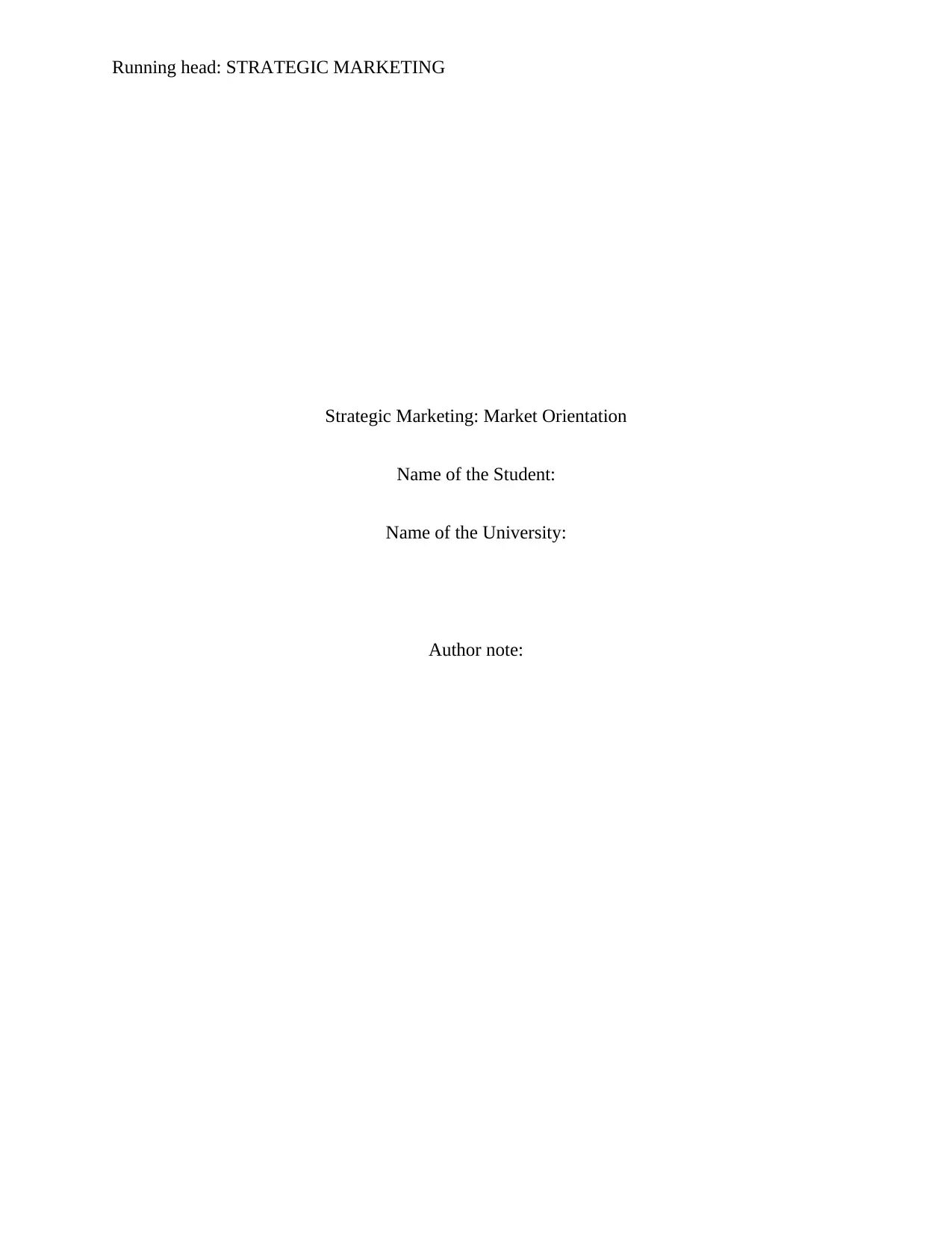
Running head: STRATEGIC MARKETING
Strategic Marketing: Market Orientation
Name of the Student:
Name of the University:
Author note:
Strategic Marketing: Market Orientation
Name of the Student:
Name of the University:
Author note:
Paraphrase This Document
Need a fresh take? Get an instant paraphrase of this document with our AI Paraphraser
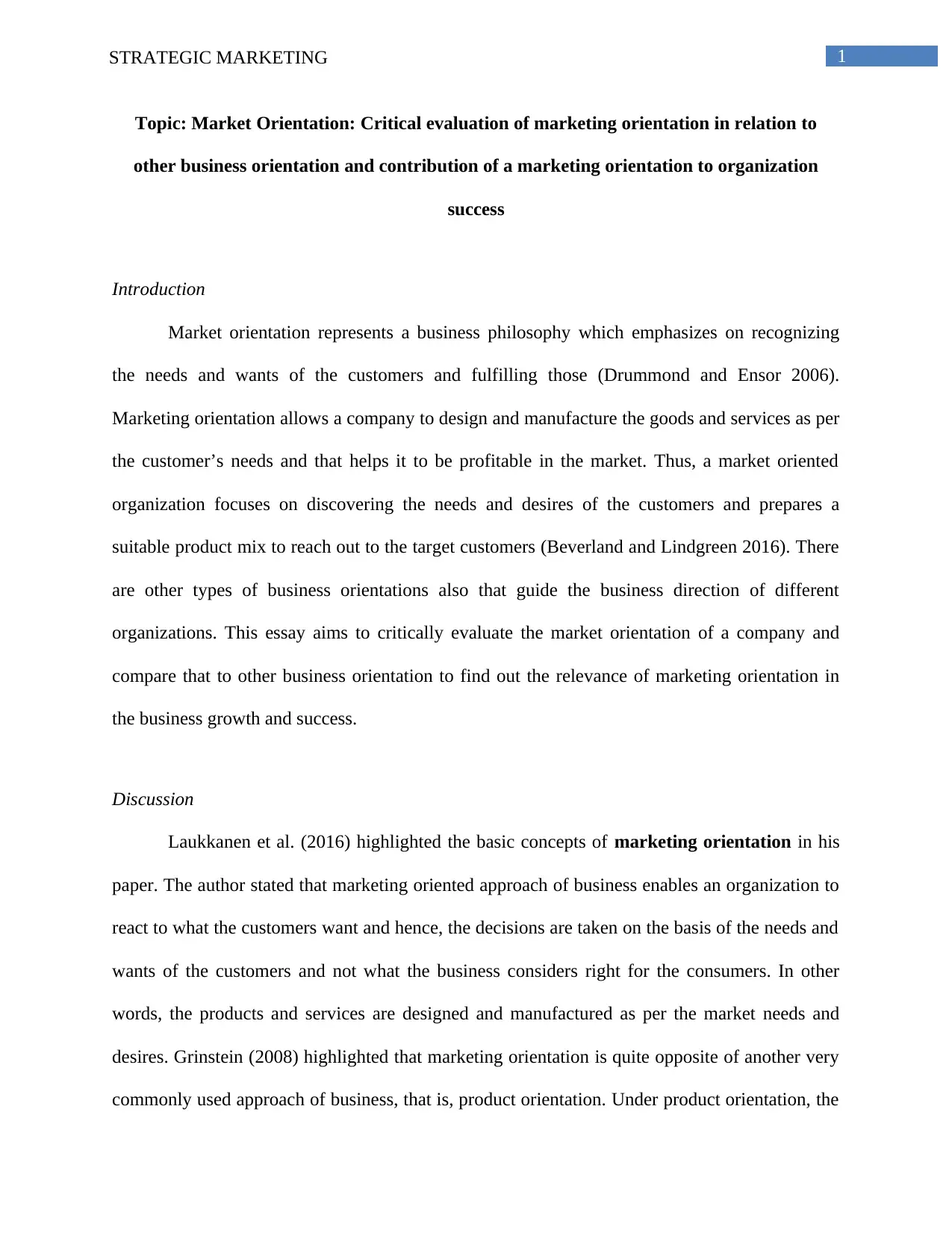
1STRATEGIC MARKETING
Topic: Market Orientation: Critical evaluation of marketing orientation in relation to
other business orientation and contribution of a marketing orientation to organization
success
Introduction
Market orientation represents a business philosophy which emphasizes on recognizing
the needs and wants of the customers and fulfilling those (Drummond and Ensor 2006).
Marketing orientation allows a company to design and manufacture the goods and services as per
the customer’s needs and that helps it to be profitable in the market. Thus, a market oriented
organization focuses on discovering the needs and desires of the customers and prepares a
suitable product mix to reach out to the target customers (Beverland and Lindgreen 2016). There
are other types of business orientations also that guide the business direction of different
organizations. This essay aims to critically evaluate the market orientation of a company and
compare that to other business orientation to find out the relevance of marketing orientation in
the business growth and success.
Discussion
Laukkanen et al. (2016) highlighted the basic concepts of marketing orientation in his
paper. The author stated that marketing oriented approach of business enables an organization to
react to what the customers want and hence, the decisions are taken on the basis of the needs and
wants of the customers and not what the business considers right for the consumers. In other
words, the products and services are designed and manufactured as per the market needs and
desires. Grinstein (2008) highlighted that marketing orientation is quite opposite of another very
commonly used approach of business, that is, product orientation. Under product orientation, the
Topic: Market Orientation: Critical evaluation of marketing orientation in relation to
other business orientation and contribution of a marketing orientation to organization
success
Introduction
Market orientation represents a business philosophy which emphasizes on recognizing
the needs and wants of the customers and fulfilling those (Drummond and Ensor 2006).
Marketing orientation allows a company to design and manufacture the goods and services as per
the customer’s needs and that helps it to be profitable in the market. Thus, a market oriented
organization focuses on discovering the needs and desires of the customers and prepares a
suitable product mix to reach out to the target customers (Beverland and Lindgreen 2016). There
are other types of business orientations also that guide the business direction of different
organizations. This essay aims to critically evaluate the market orientation of a company and
compare that to other business orientation to find out the relevance of marketing orientation in
the business growth and success.
Discussion
Laukkanen et al. (2016) highlighted the basic concepts of marketing orientation in his
paper. The author stated that marketing oriented approach of business enables an organization to
react to what the customers want and hence, the decisions are taken on the basis of the needs and
wants of the customers and not what the business considers right for the consumers. In other
words, the products and services are designed and manufactured as per the market needs and
desires. Grinstein (2008) highlighted that marketing orientation is quite opposite of another very
commonly used approach of business, that is, product orientation. Under product orientation, the
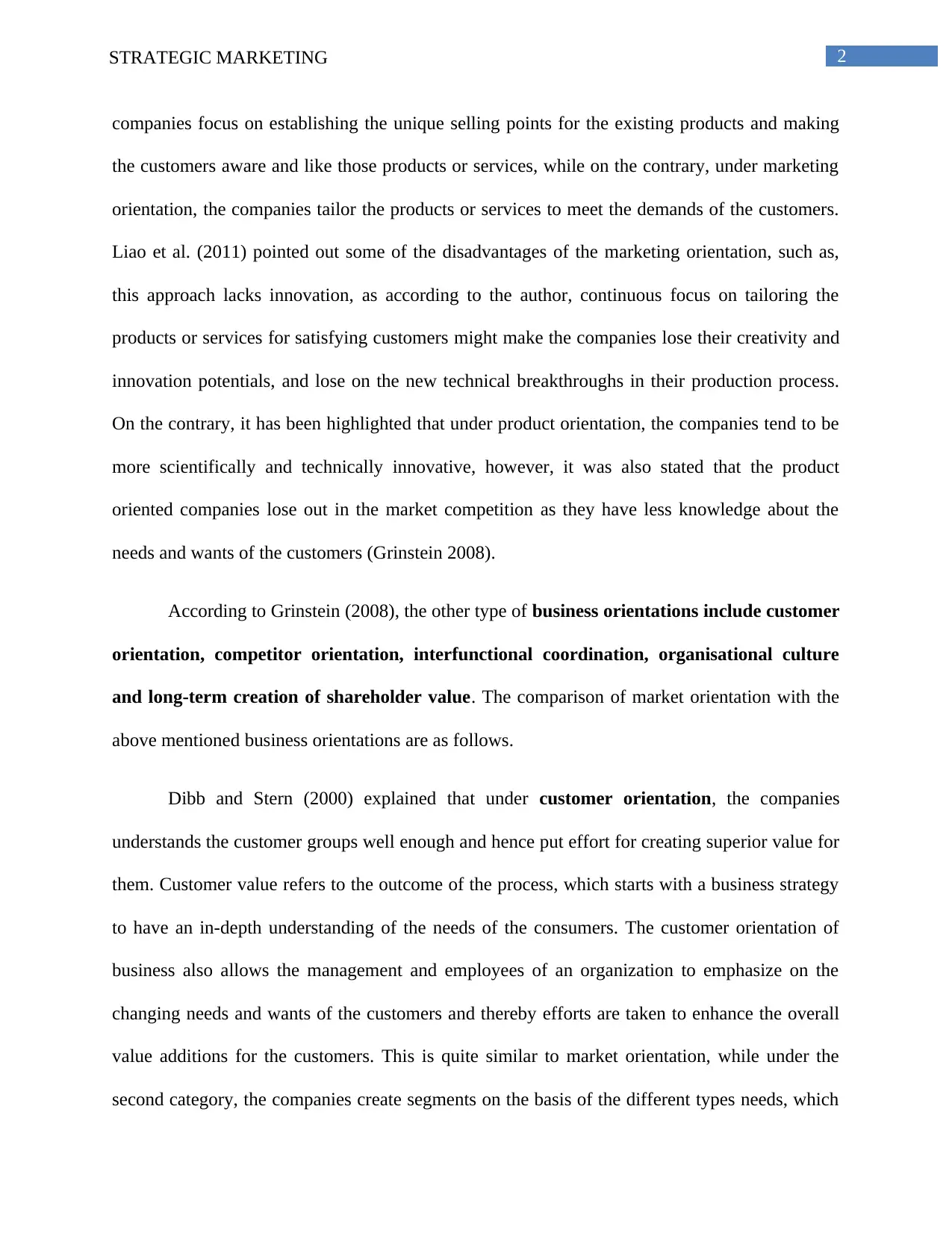
2STRATEGIC MARKETING
companies focus on establishing the unique selling points for the existing products and making
the customers aware and like those products or services, while on the contrary, under marketing
orientation, the companies tailor the products or services to meet the demands of the customers.
Liao et al. (2011) pointed out some of the disadvantages of the marketing orientation, such as,
this approach lacks innovation, as according to the author, continuous focus on tailoring the
products or services for satisfying customers might make the companies lose their creativity and
innovation potentials, and lose on the new technical breakthroughs in their production process.
On the contrary, it has been highlighted that under product orientation, the companies tend to be
more scientifically and technically innovative, however, it was also stated that the product
oriented companies lose out in the market competition as they have less knowledge about the
needs and wants of the customers (Grinstein 2008).
According to Grinstein (2008), the other type of business orientations include customer
orientation, competitor orientation, interfunctional coordination, organisational culture
and long-term creation of shareholder value. The comparison of market orientation with the
above mentioned business orientations are as follows.
Dibb and Stern (2000) explained that under customer orientation, the companies
understands the customer groups well enough and hence put effort for creating superior value for
them. Customer value refers to the outcome of the process, which starts with a business strategy
to have an in-depth understanding of the needs of the consumers. The customer orientation of
business also allows the management and employees of an organization to emphasize on the
changing needs and wants of the customers and thereby efforts are taken to enhance the overall
value additions for the customers. This is quite similar to market orientation, while under the
second category, the companies create segments on the basis of the different types needs, which
companies focus on establishing the unique selling points for the existing products and making
the customers aware and like those products or services, while on the contrary, under marketing
orientation, the companies tailor the products or services to meet the demands of the customers.
Liao et al. (2011) pointed out some of the disadvantages of the marketing orientation, such as,
this approach lacks innovation, as according to the author, continuous focus on tailoring the
products or services for satisfying customers might make the companies lose their creativity and
innovation potentials, and lose on the new technical breakthroughs in their production process.
On the contrary, it has been highlighted that under product orientation, the companies tend to be
more scientifically and technically innovative, however, it was also stated that the product
oriented companies lose out in the market competition as they have less knowledge about the
needs and wants of the customers (Grinstein 2008).
According to Grinstein (2008), the other type of business orientations include customer
orientation, competitor orientation, interfunctional coordination, organisational culture
and long-term creation of shareholder value. The comparison of market orientation with the
above mentioned business orientations are as follows.
Dibb and Stern (2000) explained that under customer orientation, the companies
understands the customer groups well enough and hence put effort for creating superior value for
them. Customer value refers to the outcome of the process, which starts with a business strategy
to have an in-depth understanding of the needs of the consumers. The customer orientation of
business also allows the management and employees of an organization to emphasize on the
changing needs and wants of the customers and thereby efforts are taken to enhance the overall
value additions for the customers. This is quite similar to market orientation, while under the
second category, the companies create segments on the basis of the different types needs, which
⊘ This is a preview!⊘
Do you want full access?
Subscribe today to unlock all pages.

Trusted by 1+ million students worldwide
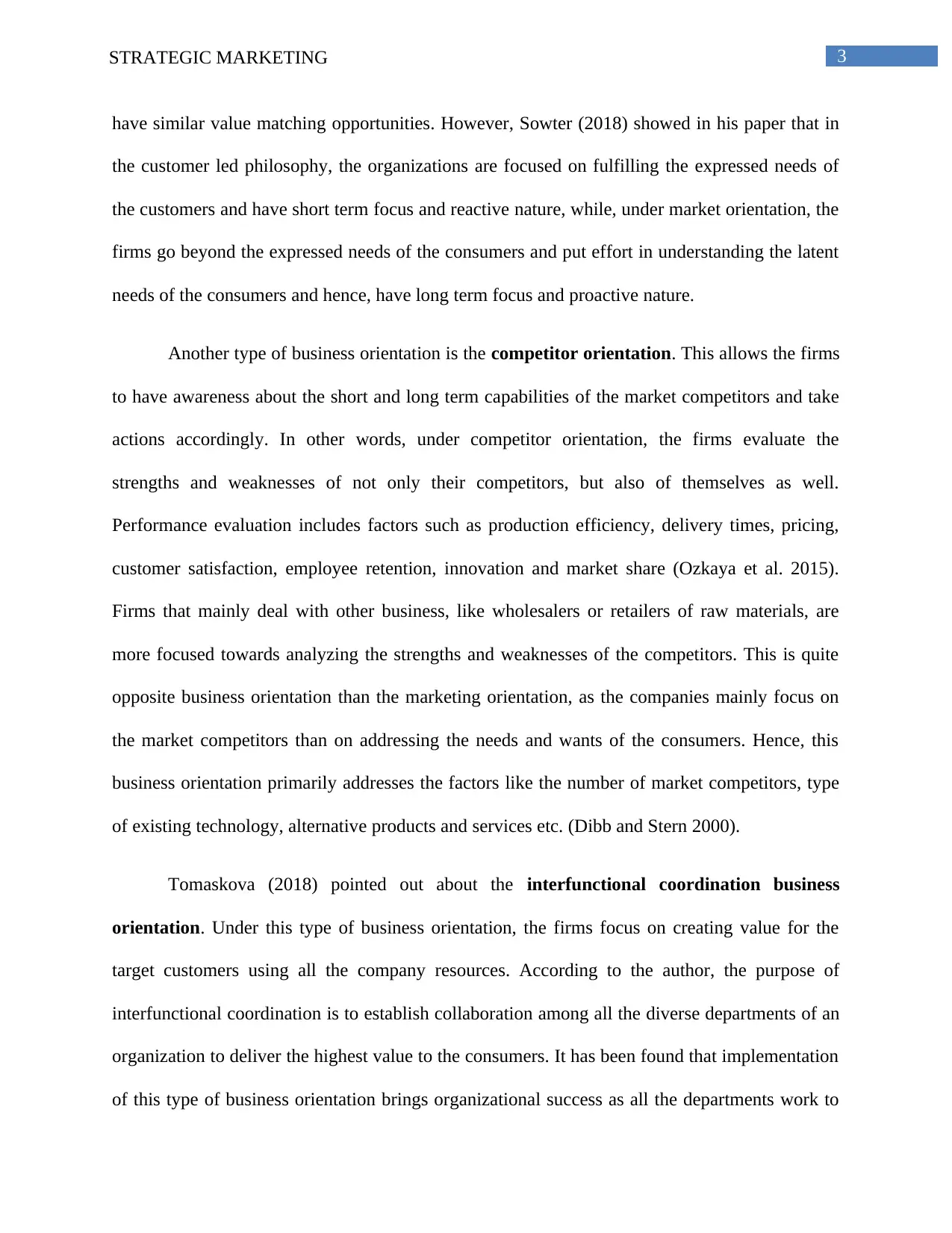
3STRATEGIC MARKETING
have similar value matching opportunities. However, Sowter (2018) showed in his paper that in
the customer led philosophy, the organizations are focused on fulfilling the expressed needs of
the customers and have short term focus and reactive nature, while, under market orientation, the
firms go beyond the expressed needs of the consumers and put effort in understanding the latent
needs of the consumers and hence, have long term focus and proactive nature.
Another type of business orientation is the competitor orientation. This allows the firms
to have awareness about the short and long term capabilities of the market competitors and take
actions accordingly. In other words, under competitor orientation, the firms evaluate the
strengths and weaknesses of not only their competitors, but also of themselves as well.
Performance evaluation includes factors such as production efficiency, delivery times, pricing,
customer satisfaction, employee retention, innovation and market share (Ozkaya et al. 2015).
Firms that mainly deal with other business, like wholesalers or retailers of raw materials, are
more focused towards analyzing the strengths and weaknesses of the competitors. This is quite
opposite business orientation than the marketing orientation, as the companies mainly focus on
the market competitors than on addressing the needs and wants of the consumers. Hence, this
business orientation primarily addresses the factors like the number of market competitors, type
of existing technology, alternative products and services etc. (Dibb and Stern 2000).
Tomaskova (2018) pointed out about the interfunctional coordination business
orientation. Under this type of business orientation, the firms focus on creating value for the
target customers using all the company resources. According to the author, the purpose of
interfunctional coordination is to establish collaboration among all the diverse departments of an
organization to deliver the highest value to the consumers. It has been found that implementation
of this type of business orientation brings organizational success as all the departments work to
have similar value matching opportunities. However, Sowter (2018) showed in his paper that in
the customer led philosophy, the organizations are focused on fulfilling the expressed needs of
the customers and have short term focus and reactive nature, while, under market orientation, the
firms go beyond the expressed needs of the consumers and put effort in understanding the latent
needs of the consumers and hence, have long term focus and proactive nature.
Another type of business orientation is the competitor orientation. This allows the firms
to have awareness about the short and long term capabilities of the market competitors and take
actions accordingly. In other words, under competitor orientation, the firms evaluate the
strengths and weaknesses of not only their competitors, but also of themselves as well.
Performance evaluation includes factors such as production efficiency, delivery times, pricing,
customer satisfaction, employee retention, innovation and market share (Ozkaya et al. 2015).
Firms that mainly deal with other business, like wholesalers or retailers of raw materials, are
more focused towards analyzing the strengths and weaknesses of the competitors. This is quite
opposite business orientation than the marketing orientation, as the companies mainly focus on
the market competitors than on addressing the needs and wants of the consumers. Hence, this
business orientation primarily addresses the factors like the number of market competitors, type
of existing technology, alternative products and services etc. (Dibb and Stern 2000).
Tomaskova (2018) pointed out about the interfunctional coordination business
orientation. Under this type of business orientation, the firms focus on creating value for the
target customers using all the company resources. According to the author, the purpose of
interfunctional coordination is to establish collaboration among all the diverse departments of an
organization to deliver the highest value to the consumers. It has been found that implementation
of this type of business orientation brings organizational success as all the departments work to
Paraphrase This Document
Need a fresh take? Get an instant paraphrase of this document with our AI Paraphraser
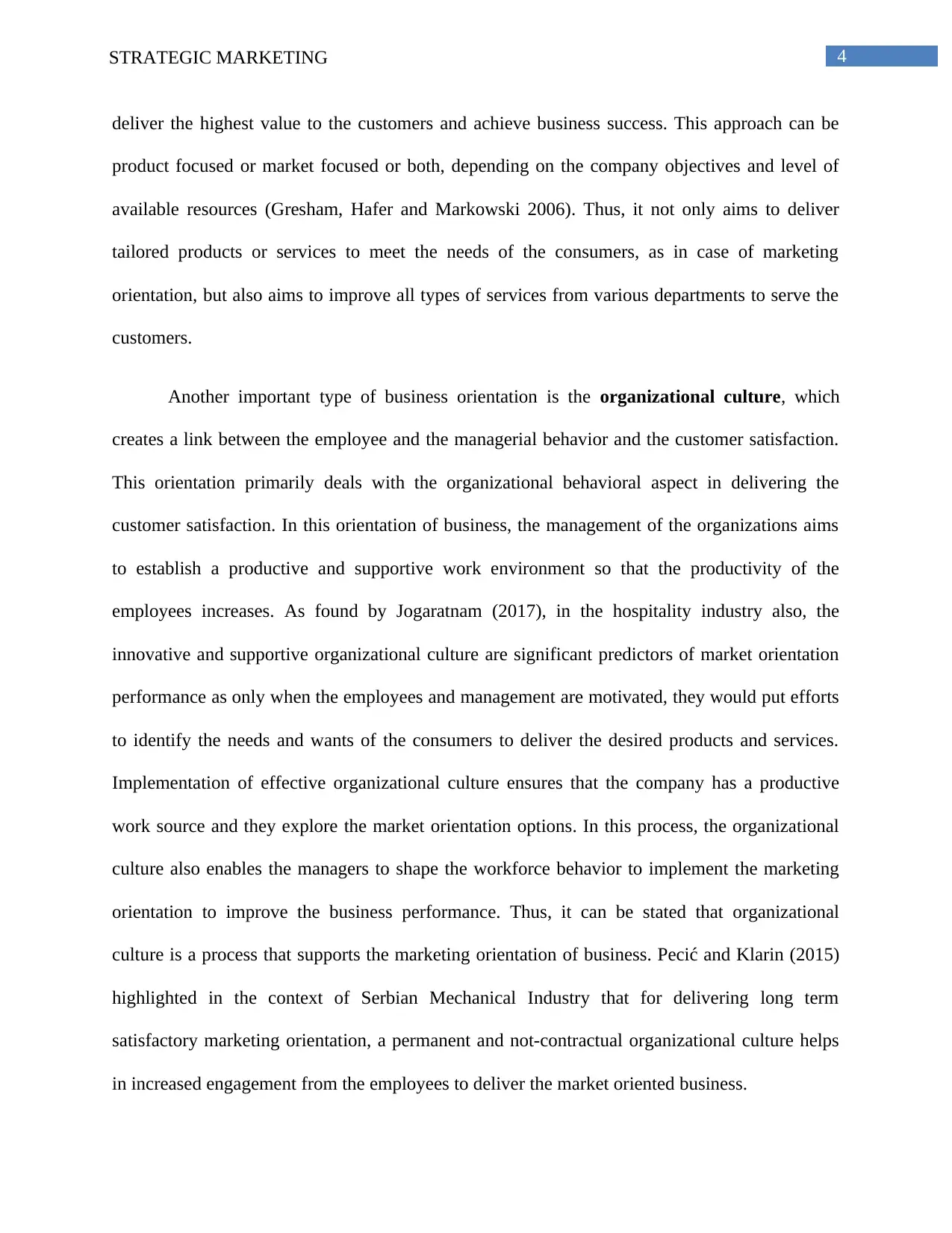
4STRATEGIC MARKETING
deliver the highest value to the customers and achieve business success. This approach can be
product focused or market focused or both, depending on the company objectives and level of
available resources (Gresham, Hafer and Markowski 2006). Thus, it not only aims to deliver
tailored products or services to meet the needs of the consumers, as in case of marketing
orientation, but also aims to improve all types of services from various departments to serve the
customers.
Another important type of business orientation is the organizational culture, which
creates a link between the employee and the managerial behavior and the customer satisfaction.
This orientation primarily deals with the organizational behavioral aspect in delivering the
customer satisfaction. In this orientation of business, the management of the organizations aims
to establish a productive and supportive work environment so that the productivity of the
employees increases. As found by Jogaratnam (2017), in the hospitality industry also, the
innovative and supportive organizational culture are significant predictors of market orientation
performance as only when the employees and management are motivated, they would put efforts
to identify the needs and wants of the consumers to deliver the desired products and services.
Implementation of effective organizational culture ensures that the company has a productive
work source and they explore the market orientation options. In this process, the organizational
culture also enables the managers to shape the workforce behavior to implement the marketing
orientation to improve the business performance. Thus, it can be stated that organizational
culture is a process that supports the marketing orientation of business. Pecić and Klarin (2015)
highlighted in the context of Serbian Mechanical Industry that for delivering long term
satisfactory marketing orientation, a permanent and not-contractual organizational culture helps
in increased engagement from the employees to deliver the market oriented business.
deliver the highest value to the customers and achieve business success. This approach can be
product focused or market focused or both, depending on the company objectives and level of
available resources (Gresham, Hafer and Markowski 2006). Thus, it not only aims to deliver
tailored products or services to meet the needs of the consumers, as in case of marketing
orientation, but also aims to improve all types of services from various departments to serve the
customers.
Another important type of business orientation is the organizational culture, which
creates a link between the employee and the managerial behavior and the customer satisfaction.
This orientation primarily deals with the organizational behavioral aspect in delivering the
customer satisfaction. In this orientation of business, the management of the organizations aims
to establish a productive and supportive work environment so that the productivity of the
employees increases. As found by Jogaratnam (2017), in the hospitality industry also, the
innovative and supportive organizational culture are significant predictors of market orientation
performance as only when the employees and management are motivated, they would put efforts
to identify the needs and wants of the consumers to deliver the desired products and services.
Implementation of effective organizational culture ensures that the company has a productive
work source and they explore the market orientation options. In this process, the organizational
culture also enables the managers to shape the workforce behavior to implement the marketing
orientation to improve the business performance. Thus, it can be stated that organizational
culture is a process that supports the marketing orientation of business. Pecić and Klarin (2015)
highlighted in the context of Serbian Mechanical Industry that for delivering long term
satisfactory marketing orientation, a permanent and not-contractual organizational culture helps
in increased engagement from the employees to deliver the market oriented business.
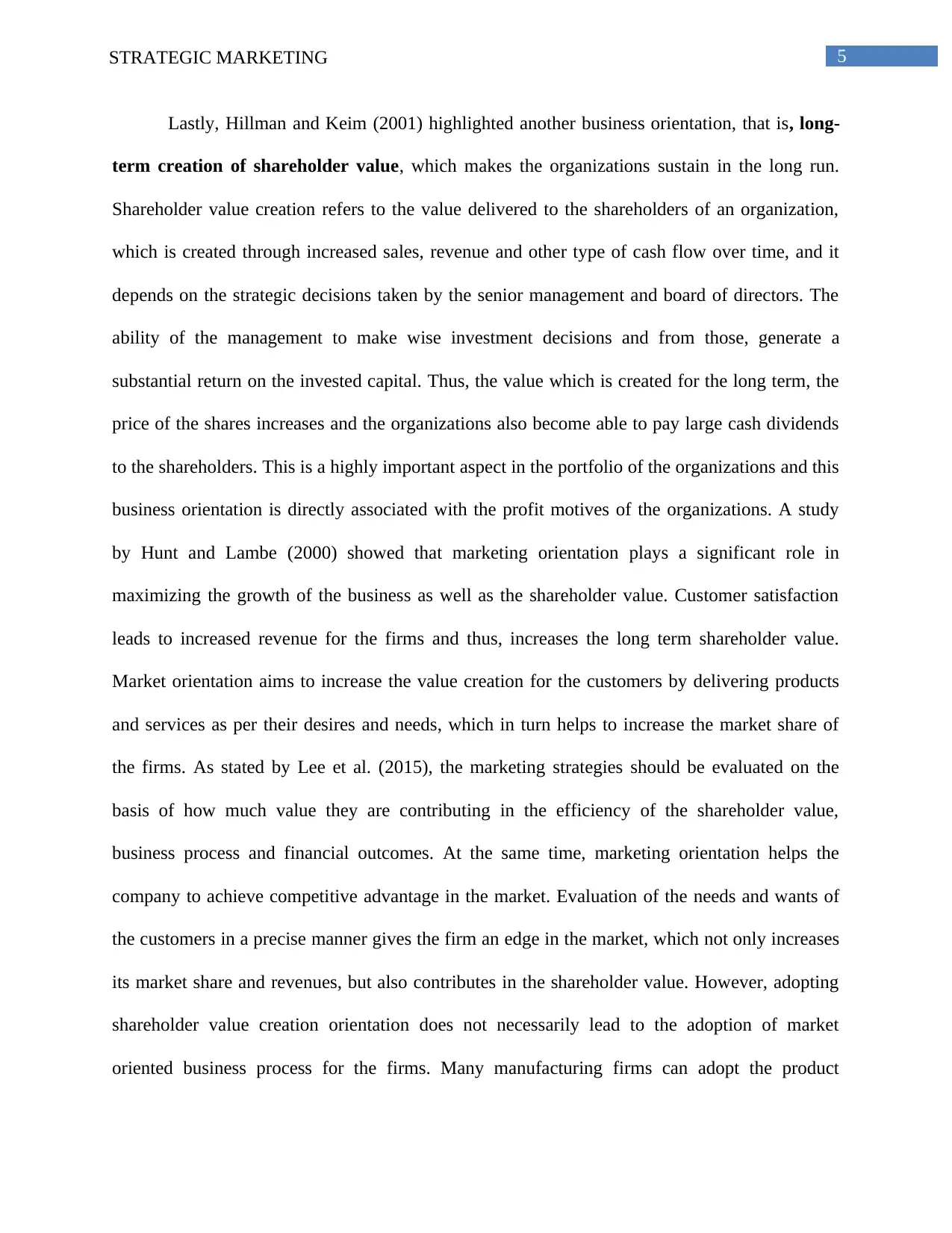
5STRATEGIC MARKETING
Lastly, Hillman and Keim (2001) highlighted another business orientation, that is, long-
term creation of shareholder value, which makes the organizations sustain in the long run.
Shareholder value creation refers to the value delivered to the shareholders of an organization,
which is created through increased sales, revenue and other type of cash flow over time, and it
depends on the strategic decisions taken by the senior management and board of directors. The
ability of the management to make wise investment decisions and from those, generate a
substantial return on the invested capital. Thus, the value which is created for the long term, the
price of the shares increases and the organizations also become able to pay large cash dividends
to the shareholders. This is a highly important aspect in the portfolio of the organizations and this
business orientation is directly associated with the profit motives of the organizations. A study
by Hunt and Lambe (2000) showed that marketing orientation plays a significant role in
maximizing the growth of the business as well as the shareholder value. Customer satisfaction
leads to increased revenue for the firms and thus, increases the long term shareholder value.
Market orientation aims to increase the value creation for the customers by delivering products
and services as per their desires and needs, which in turn helps to increase the market share of
the firms. As stated by Lee et al. (2015), the marketing strategies should be evaluated on the
basis of how much value they are contributing in the efficiency of the shareholder value,
business process and financial outcomes. At the same time, marketing orientation helps the
company to achieve competitive advantage in the market. Evaluation of the needs and wants of
the customers in a precise manner gives the firm an edge in the market, which not only increases
its market share and revenues, but also contributes in the shareholder value. However, adopting
shareholder value creation orientation does not necessarily lead to the adoption of market
oriented business process for the firms. Many manufacturing firms can adopt the product
Lastly, Hillman and Keim (2001) highlighted another business orientation, that is, long-
term creation of shareholder value, which makes the organizations sustain in the long run.
Shareholder value creation refers to the value delivered to the shareholders of an organization,
which is created through increased sales, revenue and other type of cash flow over time, and it
depends on the strategic decisions taken by the senior management and board of directors. The
ability of the management to make wise investment decisions and from those, generate a
substantial return on the invested capital. Thus, the value which is created for the long term, the
price of the shares increases and the organizations also become able to pay large cash dividends
to the shareholders. This is a highly important aspect in the portfolio of the organizations and this
business orientation is directly associated with the profit motives of the organizations. A study
by Hunt and Lambe (2000) showed that marketing orientation plays a significant role in
maximizing the growth of the business as well as the shareholder value. Customer satisfaction
leads to increased revenue for the firms and thus, increases the long term shareholder value.
Market orientation aims to increase the value creation for the customers by delivering products
and services as per their desires and needs, which in turn helps to increase the market share of
the firms. As stated by Lee et al. (2015), the marketing strategies should be evaluated on the
basis of how much value they are contributing in the efficiency of the shareholder value,
business process and financial outcomes. At the same time, marketing orientation helps the
company to achieve competitive advantage in the market. Evaluation of the needs and wants of
the customers in a precise manner gives the firm an edge in the market, which not only increases
its market share and revenues, but also contributes in the shareholder value. However, adopting
shareholder value creation orientation does not necessarily lead to the adoption of market
oriented business process for the firms. Many manufacturing firms can adopt the product
⊘ This is a preview!⊘
Do you want full access?
Subscribe today to unlock all pages.

Trusted by 1+ million students worldwide
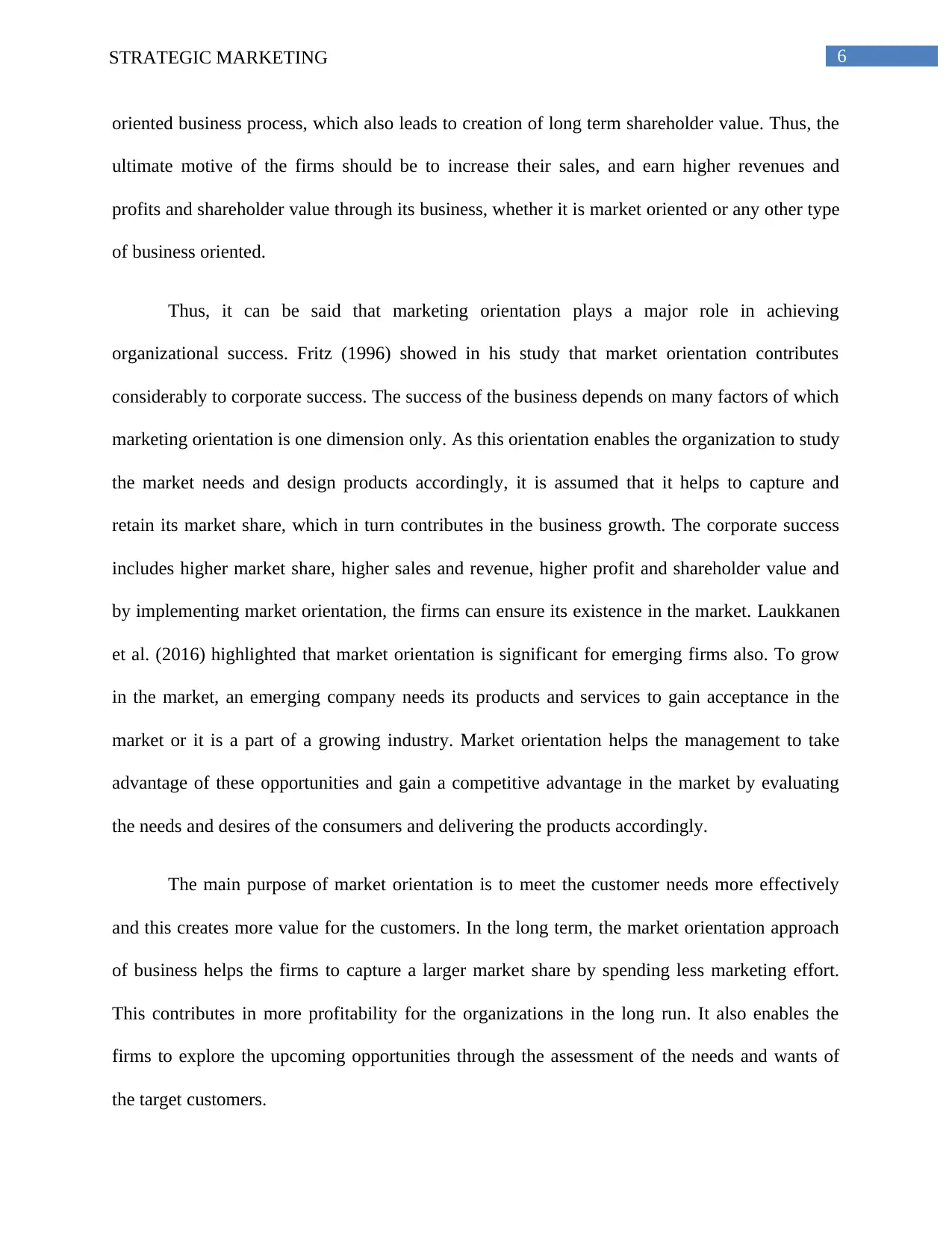
6STRATEGIC MARKETING
oriented business process, which also leads to creation of long term shareholder value. Thus, the
ultimate motive of the firms should be to increase their sales, and earn higher revenues and
profits and shareholder value through its business, whether it is market oriented or any other type
of business oriented.
Thus, it can be said that marketing orientation plays a major role in achieving
organizational success. Fritz (1996) showed in his study that market orientation contributes
considerably to corporate success. The success of the business depends on many factors of which
marketing orientation is one dimension only. As this orientation enables the organization to study
the market needs and design products accordingly, it is assumed that it helps to capture and
retain its market share, which in turn contributes in the business growth. The corporate success
includes higher market share, higher sales and revenue, higher profit and shareholder value and
by implementing market orientation, the firms can ensure its existence in the market. Laukkanen
et al. (2016) highlighted that market orientation is significant for emerging firms also. To grow
in the market, an emerging company needs its products and services to gain acceptance in the
market or it is a part of a growing industry. Market orientation helps the management to take
advantage of these opportunities and gain a competitive advantage in the market by evaluating
the needs and desires of the consumers and delivering the products accordingly.
The main purpose of market orientation is to meet the customer needs more effectively
and this creates more value for the customers. In the long term, the market orientation approach
of business helps the firms to capture a larger market share by spending less marketing effort.
This contributes in more profitability for the organizations in the long run. It also enables the
firms to explore the upcoming opportunities through the assessment of the needs and wants of
the target customers.
oriented business process, which also leads to creation of long term shareholder value. Thus, the
ultimate motive of the firms should be to increase their sales, and earn higher revenues and
profits and shareholder value through its business, whether it is market oriented or any other type
of business oriented.
Thus, it can be said that marketing orientation plays a major role in achieving
organizational success. Fritz (1996) showed in his study that market orientation contributes
considerably to corporate success. The success of the business depends on many factors of which
marketing orientation is one dimension only. As this orientation enables the organization to study
the market needs and design products accordingly, it is assumed that it helps to capture and
retain its market share, which in turn contributes in the business growth. The corporate success
includes higher market share, higher sales and revenue, higher profit and shareholder value and
by implementing market orientation, the firms can ensure its existence in the market. Laukkanen
et al. (2016) highlighted that market orientation is significant for emerging firms also. To grow
in the market, an emerging company needs its products and services to gain acceptance in the
market or it is a part of a growing industry. Market orientation helps the management to take
advantage of these opportunities and gain a competitive advantage in the market by evaluating
the needs and desires of the consumers and delivering the products accordingly.
The main purpose of market orientation is to meet the customer needs more effectively
and this creates more value for the customers. In the long term, the market orientation approach
of business helps the firms to capture a larger market share by spending less marketing effort.
This contributes in more profitability for the organizations in the long run. It also enables the
firms to explore the upcoming opportunities through the assessment of the needs and wants of
the target customers.
Paraphrase This Document
Need a fresh take? Get an instant paraphrase of this document with our AI Paraphraser
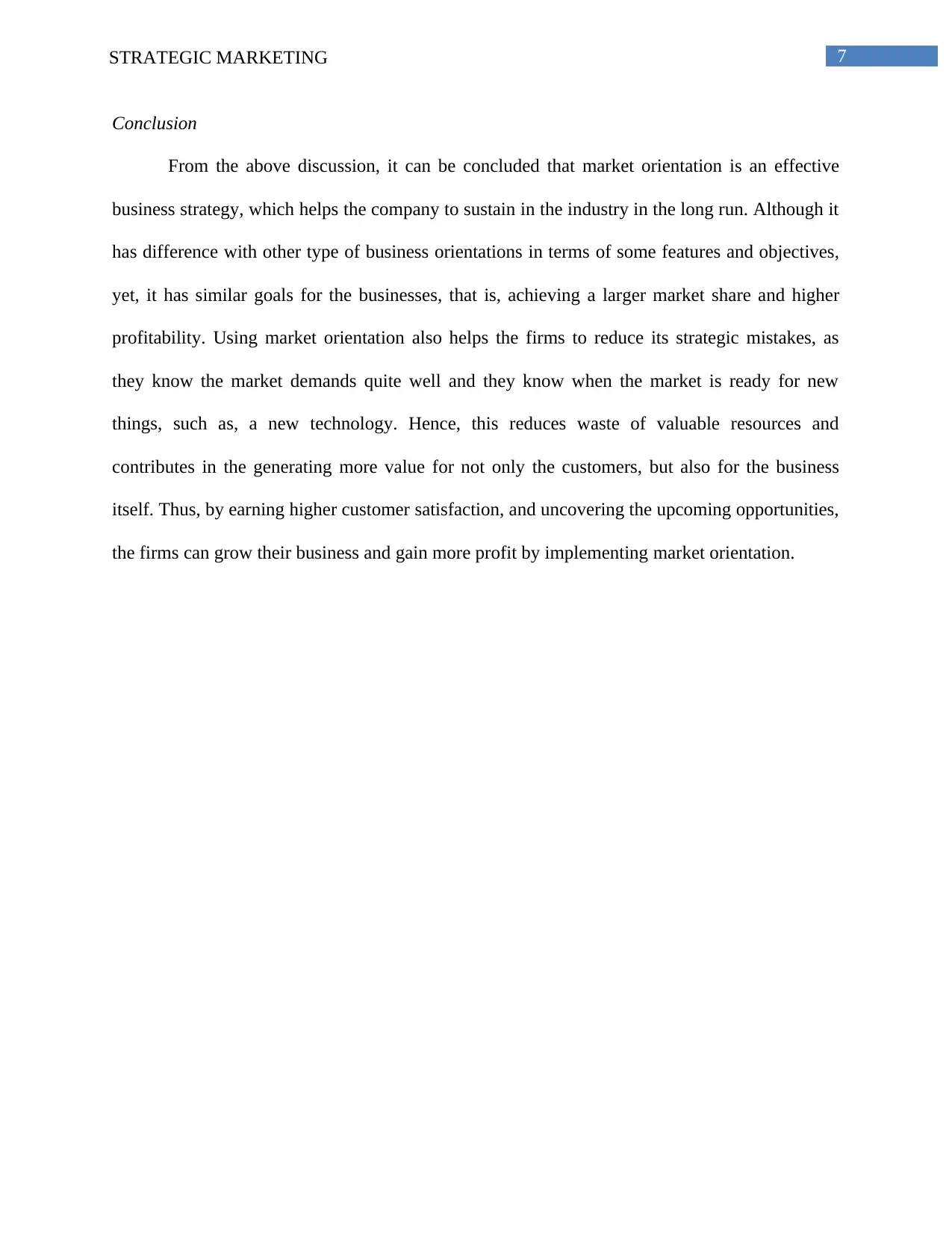
7STRATEGIC MARKETING
Conclusion
From the above discussion, it can be concluded that market orientation is an effective
business strategy, which helps the company to sustain in the industry in the long run. Although it
has difference with other type of business orientations in terms of some features and objectives,
yet, it has similar goals for the businesses, that is, achieving a larger market share and higher
profitability. Using market orientation also helps the firms to reduce its strategic mistakes, as
they know the market demands quite well and they know when the market is ready for new
things, such as, a new technology. Hence, this reduces waste of valuable resources and
contributes in the generating more value for not only the customers, but also for the business
itself. Thus, by earning higher customer satisfaction, and uncovering the upcoming opportunities,
the firms can grow their business and gain more profit by implementing market orientation.
Conclusion
From the above discussion, it can be concluded that market orientation is an effective
business strategy, which helps the company to sustain in the industry in the long run. Although it
has difference with other type of business orientations in terms of some features and objectives,
yet, it has similar goals for the businesses, that is, achieving a larger market share and higher
profitability. Using market orientation also helps the firms to reduce its strategic mistakes, as
they know the market demands quite well and they know when the market is ready for new
things, such as, a new technology. Hence, this reduces waste of valuable resources and
contributes in the generating more value for not only the customers, but also for the business
itself. Thus, by earning higher customer satisfaction, and uncovering the upcoming opportunities,
the firms can grow their business and gain more profit by implementing market orientation.
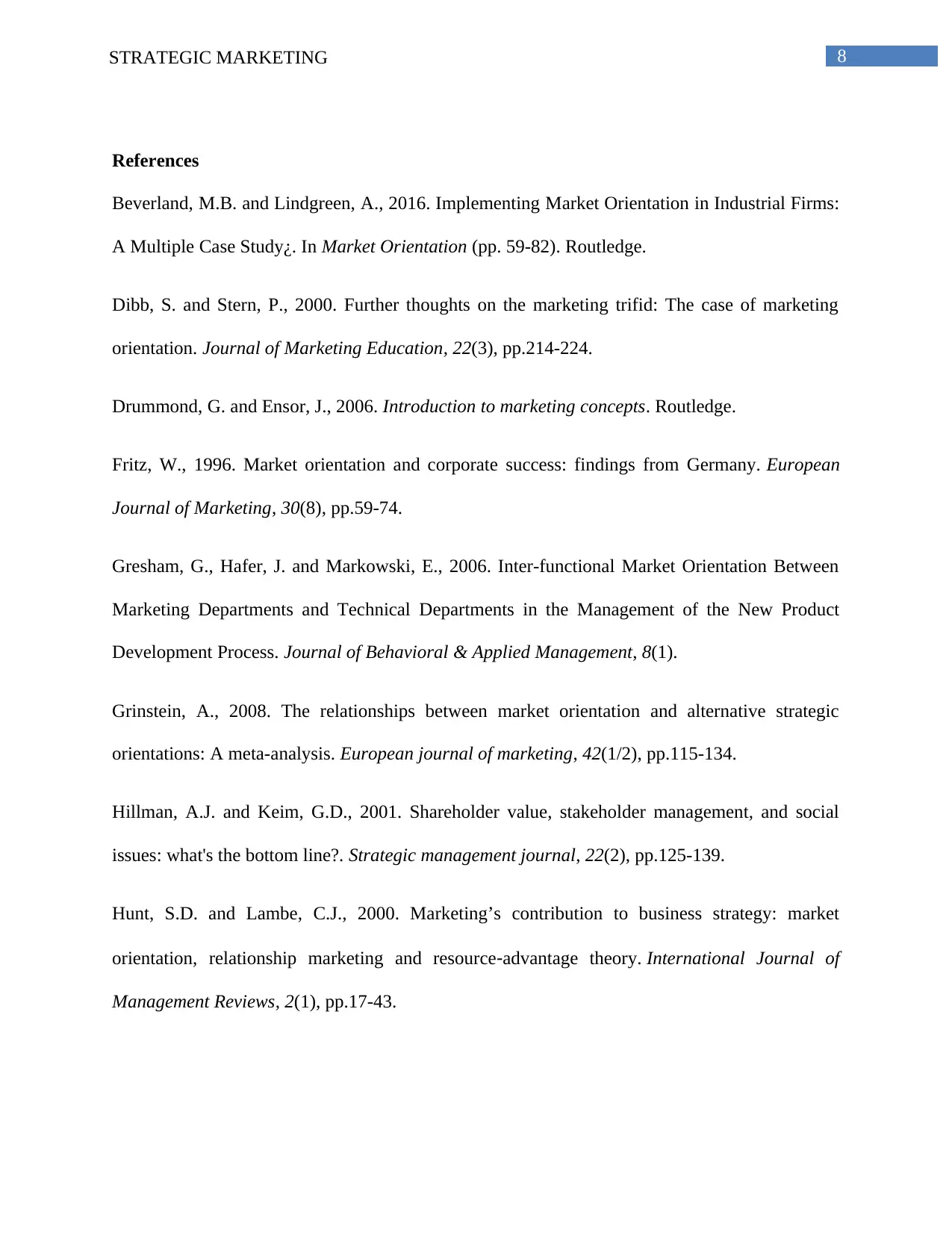
8STRATEGIC MARKETING
References
Beverland, M.B. and Lindgreen, A., 2016. Implementing Market Orientation in Industrial Firms:
A Multiple Case Study¿. In Market Orientation (pp. 59-82). Routledge.
Dibb, S. and Stern, P., 2000. Further thoughts on the marketing trifid: The case of marketing
orientation. Journal of Marketing Education, 22(3), pp.214-224.
Drummond, G. and Ensor, J., 2006. Introduction to marketing concepts. Routledge.
Fritz, W., 1996. Market orientation and corporate success: findings from Germany. European
Journal of Marketing, 30(8), pp.59-74.
Gresham, G., Hafer, J. and Markowski, E., 2006. Inter-functional Market Orientation Between
Marketing Departments and Technical Departments in the Management of the New Product
Development Process. Journal of Behavioral & Applied Management, 8(1).
Grinstein, A., 2008. The relationships between market orientation and alternative strategic
orientations: A meta-analysis. European journal of marketing, 42(1/2), pp.115-134.
Hillman, A.J. and Keim, G.D., 2001. Shareholder value, stakeholder management, and social
issues: what's the bottom line?. Strategic management journal, 22(2), pp.125-139.
Hunt, S.D. and Lambe, C.J., 2000. Marketing’s contribution to business strategy: market
orientation, relationship marketing and resource‐advantage theory. International Journal of
Management Reviews, 2(1), pp.17-43.
References
Beverland, M.B. and Lindgreen, A., 2016. Implementing Market Orientation in Industrial Firms:
A Multiple Case Study¿. In Market Orientation (pp. 59-82). Routledge.
Dibb, S. and Stern, P., 2000. Further thoughts on the marketing trifid: The case of marketing
orientation. Journal of Marketing Education, 22(3), pp.214-224.
Drummond, G. and Ensor, J., 2006. Introduction to marketing concepts. Routledge.
Fritz, W., 1996. Market orientation and corporate success: findings from Germany. European
Journal of Marketing, 30(8), pp.59-74.
Gresham, G., Hafer, J. and Markowski, E., 2006. Inter-functional Market Orientation Between
Marketing Departments and Technical Departments in the Management of the New Product
Development Process. Journal of Behavioral & Applied Management, 8(1).
Grinstein, A., 2008. The relationships between market orientation and alternative strategic
orientations: A meta-analysis. European journal of marketing, 42(1/2), pp.115-134.
Hillman, A.J. and Keim, G.D., 2001. Shareholder value, stakeholder management, and social
issues: what's the bottom line?. Strategic management journal, 22(2), pp.125-139.
Hunt, S.D. and Lambe, C.J., 2000. Marketing’s contribution to business strategy: market
orientation, relationship marketing and resource‐advantage theory. International Journal of
Management Reviews, 2(1), pp.17-43.
⊘ This is a preview!⊘
Do you want full access?
Subscribe today to unlock all pages.

Trusted by 1+ million students worldwide
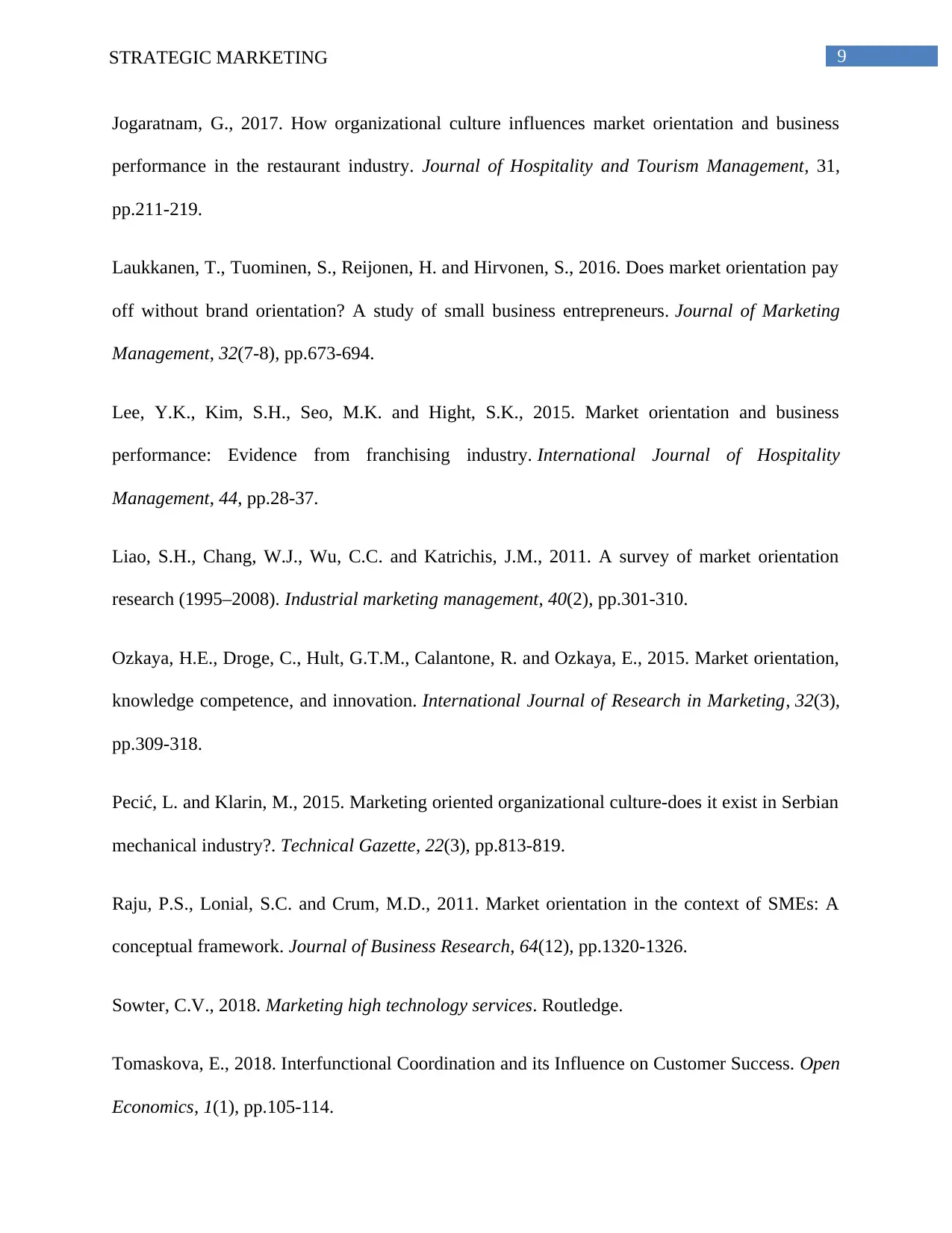
9STRATEGIC MARKETING
Jogaratnam, G., 2017. How organizational culture influences market orientation and business
performance in the restaurant industry. Journal of Hospitality and Tourism Management, 31,
pp.211-219.
Laukkanen, T., Tuominen, S., Reijonen, H. and Hirvonen, S., 2016. Does market orientation pay
off without brand orientation? A study of small business entrepreneurs. Journal of Marketing
Management, 32(7-8), pp.673-694.
Lee, Y.K., Kim, S.H., Seo, M.K. and Hight, S.K., 2015. Market orientation and business
performance: Evidence from franchising industry. International Journal of Hospitality
Management, 44, pp.28-37.
Liao, S.H., Chang, W.J., Wu, C.C. and Katrichis, J.M., 2011. A survey of market orientation
research (1995–2008). Industrial marketing management, 40(2), pp.301-310.
Ozkaya, H.E., Droge, C., Hult, G.T.M., Calantone, R. and Ozkaya, E., 2015. Market orientation,
knowledge competence, and innovation. International Journal of Research in Marketing, 32(3),
pp.309-318.
Pecić, L. and Klarin, M., 2015. Marketing oriented organizational culture-does it exist in Serbian
mechanical industry?. Technical Gazette, 22(3), pp.813-819.
Raju, P.S., Lonial, S.C. and Crum, M.D., 2011. Market orientation in the context of SMEs: A
conceptual framework. Journal of Business Research, 64(12), pp.1320-1326.
Sowter, C.V., 2018. Marketing high technology services. Routledge.
Tomaskova, E., 2018. Interfunctional Coordination and its Influence on Customer Success. Open
Economics, 1(1), pp.105-114.
Jogaratnam, G., 2017. How organizational culture influences market orientation and business
performance in the restaurant industry. Journal of Hospitality and Tourism Management, 31,
pp.211-219.
Laukkanen, T., Tuominen, S., Reijonen, H. and Hirvonen, S., 2016. Does market orientation pay
off without brand orientation? A study of small business entrepreneurs. Journal of Marketing
Management, 32(7-8), pp.673-694.
Lee, Y.K., Kim, S.H., Seo, M.K. and Hight, S.K., 2015. Market orientation and business
performance: Evidence from franchising industry. International Journal of Hospitality
Management, 44, pp.28-37.
Liao, S.H., Chang, W.J., Wu, C.C. and Katrichis, J.M., 2011. A survey of market orientation
research (1995–2008). Industrial marketing management, 40(2), pp.301-310.
Ozkaya, H.E., Droge, C., Hult, G.T.M., Calantone, R. and Ozkaya, E., 2015. Market orientation,
knowledge competence, and innovation. International Journal of Research in Marketing, 32(3),
pp.309-318.
Pecić, L. and Klarin, M., 2015. Marketing oriented organizational culture-does it exist in Serbian
mechanical industry?. Technical Gazette, 22(3), pp.813-819.
Raju, P.S., Lonial, S.C. and Crum, M.D., 2011. Market orientation in the context of SMEs: A
conceptual framework. Journal of Business Research, 64(12), pp.1320-1326.
Sowter, C.V., 2018. Marketing high technology services. Routledge.
Tomaskova, E., 2018. Interfunctional Coordination and its Influence on Customer Success. Open
Economics, 1(1), pp.105-114.
Paraphrase This Document
Need a fresh take? Get an instant paraphrase of this document with our AI Paraphraser

10STRATEGIC MARKETING
1 out of 11
Related Documents
Your All-in-One AI-Powered Toolkit for Academic Success.
+13062052269
info@desklib.com
Available 24*7 on WhatsApp / Email
![[object Object]](/_next/static/media/star-bottom.7253800d.svg)
Unlock your academic potential
Copyright © 2020–2025 A2Z Services. All Rights Reserved. Developed and managed by ZUCOL.




